Ancient Oyster Shells Are Windows to the Past
Like thousands of soap-dish-sized Rosetta stones, the shells can reveal clues about the past—if you know what you’re looking for
/https://tf-cmsv2-smithsonianmag-media.s3.amazonaws.com/filer/04/d2/04d240a3-d6ed-4e07-ad1c-aa07d425a1b9/collecting-paleo-oyster.jpg)
This article is from Hakai Magazine, an online publication about science and society in coastal ecosystems. Read more stories like this at hakaimagazine.com.
Stephen Durham ignores the cold water seeping into his hiking boots as he wades into a shallow, brackish creek wending through a salt marsh in Madison, Connecticut. With each step, shells crunch under his feet and he sentences a few more oysters to an early death. Below these casualties, the remains of their ancestors lie entombed in the muck. Less than a meter down, they could be hundreds of years old—artifacts of a time before modern record-keeping. Like thousands of soap-dish-sized Rosetta stones, the shells can reveal clues about the past—if you know what you’re looking for.
Durham, sporting a trimmed grad-student beard and a hat from a seafood restaurant, is a new kind of sleuth. He’s one of the world’s first students trained in conservation paleobiology, a young field that applies a paleontologist’s skill set to modern-day conservation challenges by decoding animal and plant remains. Research led by The Nature Conservancy indicates that, globally, oyster populations have declined by 85 percent over the past 130 years. The information Durham can glean from the old eastern oyster (Crassostrea virginica) shells in this small marsh—like how salty the water was when they lived, how big and how quickly they grew, and how tightly clumped they were—could provide valuable context for efforts to conserve and restore eastern oyster reefs today. But the people responsible for that restoration work are going to need some convincing.
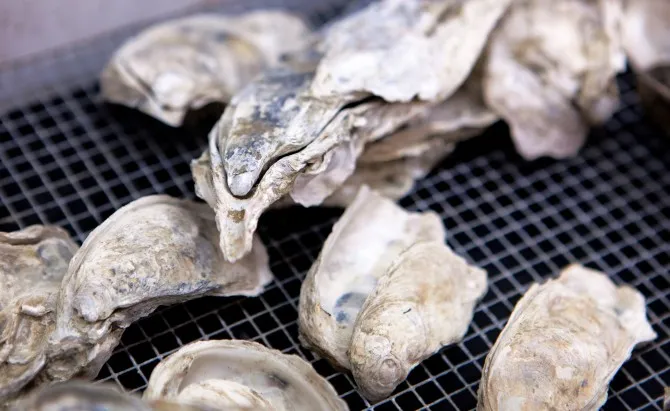
The creek must be empty before Durham can dig down into the carbon-rich, sulfur-smelling mud and collect his samples. But at the minute of dead low tide, water still streams around his ankles. Unfazed, Durham carries on with his other task: plucking living oysters from the creek bed surface for comparison purposes. He’s got plenty of antique mussels waiting back at his lab, a five-hour drive away.
Durham, along with his PhD adviser Gregory Dietl, has excavated thousands of eastern oyster shells from sites in Louisiana, the Carolinas, and Connecticut over the past several years. At his office at the Cornell University-affiliated Paleontological Research Institution in Ithaca, New York, they’re piled on shelves and in drawers, some still covered in marsh muck and wrapped in plastic collection bags, others cleaned, sorted, neatly labeled, and boxed. The smallest shells are just a few millimeters long; the biggest are longer than an iPhone. The shells vary in age; some are relatively young at a few decades to centuries old, like those from the creek in Connecticut, while his oldest shells date back hundreds of thousands of years to the Pleistocene. Those older shells aren’t even from modern marshes: Durham and Dietl find them exposed along the walls of canals, in places where marshes once existed farther inland when ocean levels were higher. They often find these old shells intact, with both halves upright like they would have been when the oysters were alive, before marsh silt buried them millennia ago.
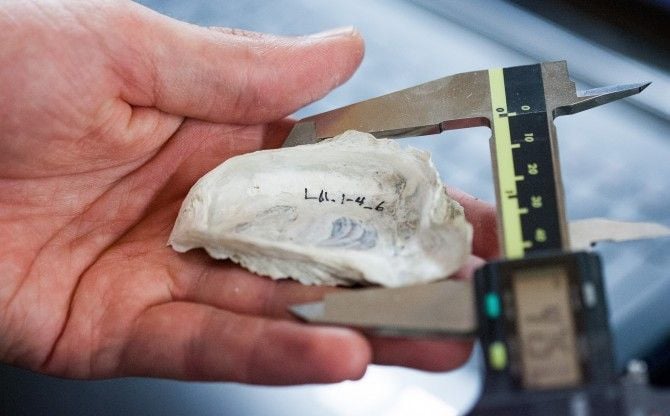
In the lab down the hall from his office, a few days after he’s returned from Connecticut, Durham hoses off 350,000-year-old samples from a site in South Carolina, the shells arrayed on wire mesh over a sink. After he has cleaned each bagged sample, he combs through the collection and matches single oyster shells into pairs, like an ancient jigsaw puzzle. “Ta-da,” he says, holding up a set. With both halves, he can be sure that he’s measuring an oyster’s full size and that it lived near the collection site and wasn’t just washed there by waves or tidal currents.
From there, Durham sets about turning old calcium carbonate into hard data. He selects a few shells for analysis, saws them in half, and then zaps the cut surfaces with a laser to measure the ratios of elements such as magnesium, calcium, and barium. The ratio of magnesium to calcium changes with temperature, so he can deduce the lifespan of an oyster by seeing how many hot and cold seasons it lived through. And barium and calcium ratios in the shell material vary slightly with local salinity, indicating how salty the water was at the time the oyster lived.
There’s even information in the detritus that he washes off the shells. As he brushes aside shell bits piled on the wire mesh, they jingle like broken glass. He picks out an impossibly small snail shell, not much larger than a hangnail. “Boonea impressa,” he declares: an oyster parasite. Its presence, and the presence of other non-oyster shells in the sample—all from species still alive today—reveals more about the environment the oysters came from. For example, Boonea lives in a narrower range of salinities than the eastern oyster, so the ancient sample provides further evidence for how salty the water was all those years ago at the spot in South Carolina where this particular batch of shells is from.
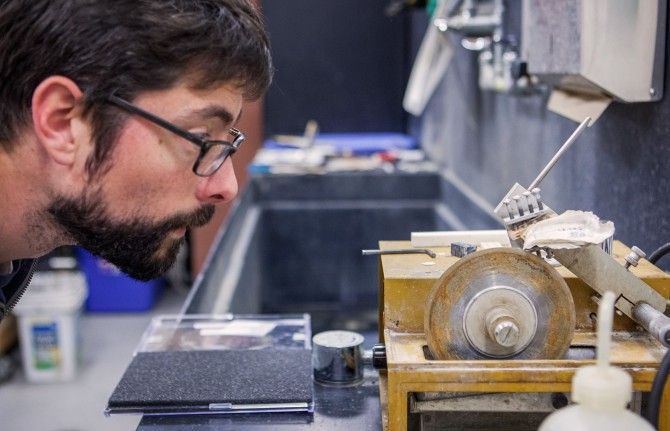
Conservation paleobiology can provide a remarkably complete picture of how oysters or other organisms lived well before humans arrived on the scene. “We can tell managers what oyster populations looked like in the past,” says Durham. The question now is: “What are the things they want to know?”
Hot on the heels of that question comes the quandary of how to get the information into circulation. The field of conservation paleobiology was first named in 2002, though scientists have been employing its techniques for several decades; in 2009, Dietl helped organize presentations about it at a meeting of the Geological Society of America. The emerging field now boasts members across the Americas, Europe, and Australia. And the scope of work extends beyond oysters: conservation paleobiologists have used pollen and traces of seeds to determine whether some Galapagos plants were originally native or invasive, for example, and they have studied fossil corals to show shifts in distribution in response to large-scale climate changes. Yet many restoration managers are still unaware of the field—or remain skeptical.
Many are “intrigued, but slightly suspicious,” about paleobiological data, says Rowan Lockwood, a geology professor and conservation paleobiologist at the College of William and Mary in Virginia. “This is a new source of data for them, and I don’t think they’re completely convinced.” That sentiment was echoed in the results of a survey completed by about 100 people working on oyster restoration in the United States and published by Durham and Dietl last year.
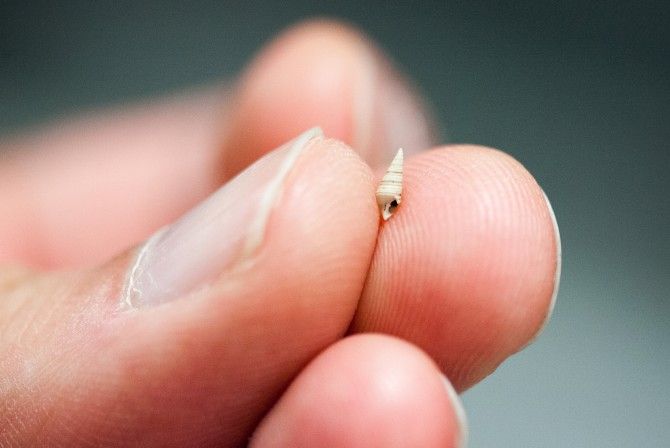
Some think that the secrets of ancient shells have limited value for planning restoration efforts today. “There have been a heck of a lot of changes in oyster reefs in the last 200 years,” says Philine zu Ermgassen, who studies marine ecosystem services at the University of Cambridge. “To ignore that fact would be exceedingly naive.” It’s more important, she says, to understand the current conditions.
Durham and Dietl argue that restoration scientists should simply factor paleobiological data into their equations—along with current conditions. One of the strengths of their information is that it can help avoid the pitfall of “shifting baselines.” That’s the idea that the world during our lifetime, or in the very recent past, is our model—or baseline—for how the world ought to look, even if that world is, or was, already severely degraded.
“If you’re setting goals based on something that’s already completely degraded, you may be undershooting a lot,” Dietl says. Neither he nor even the most optimistic oyster restorers expect the coastline to ever look the way it did before industrial harvesting and coastal development decimated populations. Still, this type of historical data can help ensure that restoration goals are appropriately ambitious and well-suited to the environmental conditions. “Maybe you could restore it to be better, but you have no idea because your measure of success is looking at a reef that’s been degraded for a century.”
Conservation paleobiology has at least one oyster success so far. At a site near Florida’s Everglades, restoration managers used paleobiological data gathered in 2007 and 2008 to help set targets for reef recovery and to figure out how to restore freshwater flow in a way that would most benefit the oysters. The data, explains Aswani Volety, who was involved in the project and is now a professor of marine science specializing in shellfish biology and habitat restoration at the University of North Carolina Wilmington, also showed the team that oysters had never been present in certain bays, so trying to “restore” them to those areas could prove futile.
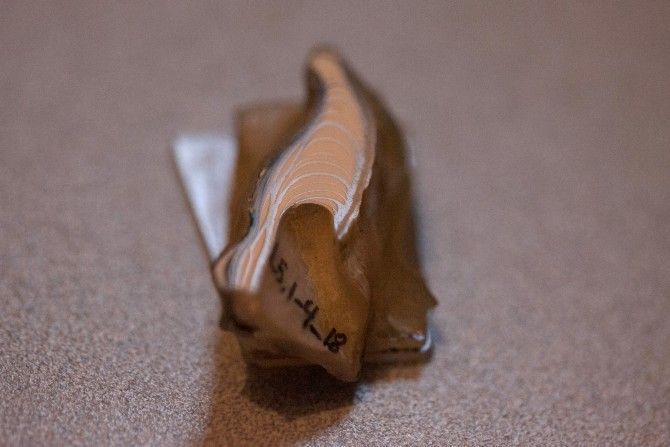
The shells from South Carolina that Durham is washing and sorting in his lab are from a time between ice ages when the world was, on average, about 1 to 2 °C warmer than it is today. That means that the shells may also be proxies for what oysters will look like in the near future. So far, his data suggests that oysters in warmer climates are smaller and shorter-lived. That may be important information for restoration managers, since restoration targets can include oyster biomass and age metrics.
Paleobiological data can also help tell a powerful story about what has been lost, which can generate local support for restoration projects. People aren’t likely to fight for something if they don’t know it existed. But show someone evidence of what they’ve lost, says Dietl, and perhaps they’ll say, “‘I did lose something. Maybe we should get that back.’”
At his cramped basement lab, Durham clamps another shell onto a moveable arm and powers up the diamond saw. The blade screeches like a rusted muffler scraping across concrete as it slowly severs hundreds of thousands of years of history.
Once the cut is complete, he holds up the shell and examines the raw edge, with its many layers of possibility.
Read more coastal science stories at hakaimagazine.com.